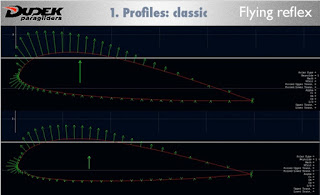Reflex airfoil in paragliders
One of the paraglider pilots from Poland has
explained quite well with simple words how the reflex airfoil in our gliders
works and what makes it 'safe'.
At the very beginning I have to apologise to all aerodynamic experts for the
simplifications which I have had to make to make this article comprehensible to all paraglider pilots.
To explain what a reflex airfoil is we have
to go back to the beginning of aviation. These were times when planes looked
like flying scaffolding. Some designers decided to get rid of the plane's tail.
The problem was that the airplane was then pitching down. Why was it pitching
down? Apparently the lift force which
was created by the wing was fixed to the point behind center of airplane's
gravity causing the rotation.
The point where lift force was 'attached'
to the wing is called the center of pressure. Its value and position depends on
the total sum of all the forces acting on the airfoil. The airfoil is simply a
wing's cross-section.
To solve the pitching problem described
above the only solution is to put the center of pressure at the same place as
the center of gravity. Only then will the weight of the wing (airplane) will be
pulling the wing down and the lift force will be pulling the wing up without
rotation in any direction (which means without changing the angle of attack).
Unfortunately the airplane has to
pitch the nose down during landing. When
the angle of attack decreased, the center of pressure was moving backwards but
the center of gravity stayed in the same place. This caused an increasing
tendency to pitch the nose down.
The same effect was obtained when the angle
of attack was increased (the nose was pitching up). The center of pressure movies
forward and causes the wing to pitch up more.
The breakthrough was when aerodynamic
experts designed an airfoil (reflex airfoil) where the center of the pressure
was working in the opposite way - causing the nose to pitch down when the angle
of attack was increased and vice-versa. This happened as early as 1906. (A lot of people who think that the reflex
airfoil was invented by/for paraglider pilots).
These two pictures will be helpful to
understand what is the difference between classic and reflex airfoils.
Classic airfoil:  |
The top picture shows the wing flying on a
high angle of attack. The lower picture shows the airfoil on a small angle of
attack. The arrows show the pressure distribution along the airfoil and the
arrow 'inside' the airfoil shows the magnitude of the lift force and its
attachment point (the center of pressure). You can see that when lowering the
angle of attack the point of pressure is moving backwards.
Reflex airfoil:
This picture shows the reflex airfoil
flying on high (upper picture) and low (lower picture) angle of attack. The
arrow inside the airfoil shows how the center of pressure moves forward when
the angle of attack is decreased.
This is the end of part one. Next part will
be published in one week.
Take your time to understand the above
because in the next part we will look more into what is happening to the
airfoil when it is changing angle of attack in the reflex mode.
The author of the original text is Zbigniew Gotkiewicz. It was presented on www.paramotor.com.pl Leszek's blog
If you have any questions please post a comment or send an email to lukaszpg (at) gmail.com








































